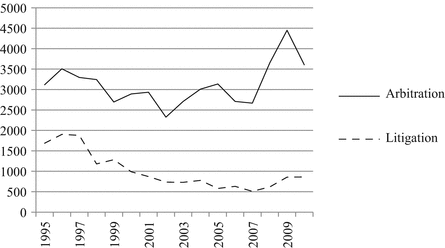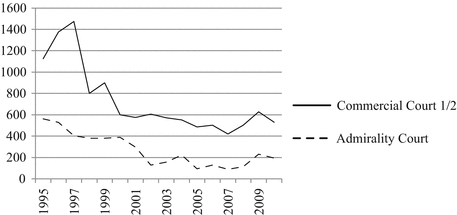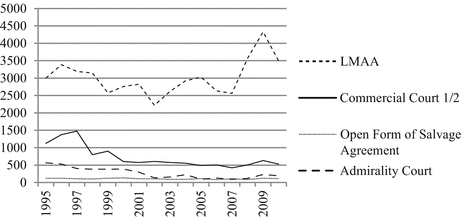Maritime Law

Figure 1
Maritime Cases in German Courts
(see p. 133).
The situation, however, seems to be different before British courts. In Great Britain, the Commercial Court and the Admiralty Court have jurisdiction over maritime cases. The numbers that have been observed here are considerably higher than the numbers before German courts. Yet, the numbers are decreasing. Whereas in the years 1995–1997 approximately 2,000 cases were decided before state courts, in the following years only 800–1,000 cases were decided. This is illustrated in figure 2 (see p. 133), in which the number of cases in the Commercial Court is divided by two because only 50% of commercial court cases are maritime cases.6


Figure 2
Maritime Cases in British Courts
Even though the caseload of maritime cases in British courts is much higher than in German courts, one can see a considerable decrease between the years 1995 and 2011. The degree to which a de-nationalization of maritime law can be observed becomes clear if one contrasts these numbers with the caseload of maritime arbitrators. Particularly in London, maritime arbitration is strongly based in the London Maritime Arbitrator’s Association (LMAA). During the last years, the LMAA has had a caseload of approximately 3,000–4,000 cases per year. Another important arbitration association in London is Lloyd’s Salvage Arbitration Branch, which offers arbitration on claims resulting from the open form salvage agreement. This arbitral process is used to decide on the amount of salvage money that a maritime salvor can claim.7 Figure 3 (see p. 134) shows that maritime arbitration is much more important for maritime dispute resolution than the state courts.


Figure 3
Maritime Cases in Great Britain
The ratio between private arbitration and litigation before state courts becomes even more pronounced if the numbers of cases before state courts and the caseload attributable to arbitration associations are combined (figure 4) (see p. 134).8


Figure 4
Maritime Cases in Great Britain (combined)
Those numbers, of course, are only valid for Great Britain. But maritime arbitration also exists in other places. In New York, for instance, the Society of Maritime Arbitrators (SMA) is the second largest maritime arbitration institute in the world after the LMAA. The SMA has a caseload of approximately 500 cases per year. 9 Thus, the LMAA and the SMA handle 90% of the worldwide caseload in maritime arbitration.10
These numbers show that the maritime industry is not necessarily reliant on litigation and state courts. Maritime arbitration has a much greater importance for dispute resolution in this field.11 Therefore Basedow’s observation of a de-nationalization of maritime law can be confirmed at least to the extent that a corresponding tendency can be observed.
But a de-nationalization can be observed not only in the field of third-party dispute resolution but also in the field of private lawmaking.
III. Private Lawmaking
Most transactions in international maritime trade are based on standard form contracts. Standard form contracts, however, are often criticized for being one-sided and unfair and for not reflecting public policy and public goods. This may hold true for many standard contracts. They are usually unproblematic from an organizational point of view since they standardize business transactions and thus reduce transaction costs. Standard contract terms become a legal problem when one party uses them to redistribute contractual risks in its own favour. In that case, standard form contracts can even become unconscionable.
International trade, however, has established processes in which standard form contracts are developed in discursive and participative procedures. Thus, they are not one-sided and coercive, but well negotiated among many, if not all, stakeholders. In the following section I will introduce some of the features of such contracts.
1. Private Lawmaking in the Shipping Industry
Within the shipping industry the Baltic and International Maritime Council (BIMCO) plays a major role in drafting and distributing standard charter parties and other standard contracts. The objective is to produce standard forms and other shipping documents that strike a fair and equitable balance between the parties, that are legally sound, and that can be understood by everyone involved.12
The drafting process of standard contracts at BIMCO always follows a similar pattern. The “BIMCO Documentary Committee” coordinates all BIMCO activities in the field of standard contracts. The Documentary Committee has members with various backgrounds in the shipping industry who serve as agents and representatives for their respective organization. Among the members of the Documentary Committee are representatives of several states,13 protection and indemnity insurance providers (P&I clubs), shipping companies as well as international shipping associations – such as the “International Chamber of Shipping” or the “Federation of National Associations of Ship Brokers and Agents” (FONASBA) – and finally members of the BIMCO secretariat.14 In addition, prior to a modification of existing standard forms or at the beginning of the drafting process of a new form, all BIMCO members are asked for their opinion, and their experience with existing standard forms is evaluated. This form of participation also increases the acceptance of standard contracts in the industry.
After preparatory evaluations, a smaller group, the subcommittee, starts the specific drafting process. The subcommittee, again, consists of members who represent ship-owning/shipbroking and ship-operating interests. After the drafting process is finished, the document will be put forward to the Documentary Committee for formal approval.15 That means that every stakeholder in the shipping industry – along with his/her specific interests – was represented in the drafting process of a standard contract form which will later be distributed and widely used in international shipping.
Another example for the creation of private rules in the shipping industry is the Comité Maritime International (CMI). The CMI is a private organization founded in 1897 that drafts, publishes, and administers – alongside many other rules and regulations – the so-called “York-Antwerp Rules” (YAR). The YAR are regulations on the maritime legal instrument of “general average” (French: havarie grosse) that is essential in the shipping industry. The rules on general average go back to the pre-Christian 8th century16 and reflect the fact that shipping has always been a risky venture for several parties. Not only does the ship-owner bear the risk of losing the ship in heavy weather or rough seas, but the cargo-owners are similarly subject to the risk of losing their property. The rules on general average accommodate this fact; if a ship and its cargo are at risk of being lost, the captain might order the crew to abandon some of the cargo and throw it over board or, in earlier times when vessels usually were sailing ships, they would cut the mast to save the entire ship or the rest of the cargo. In those cases, general average rules make everyone involved in the journey liable for any loss incurred by a cargo-owner or ship-owner. That means that if one cargo-owner loses his cargo, which was abandoned in order to save the ship and the rest of the cargo, he can claim compensation from the other parties.17 These rules still apply today but revisions must be made periodically. The revisions, however, are handled by the CMI, and its members, as in the case of BIMCO, are representatives of various stakeholders of the maritime industry such as insuring companies, ship-owners, carriers and freight-forwarders, lawyers, and many other interest groups.18 The revision process is a discursive process in which many different and partly concurring interests have to be accommodated. Here, once again, the drafting and revision process is not one-sided but very balanced in order to suit the needs of everyone involved.
2. The UCP as an Example of Private Lawmaking
Another example of a standard contract form which is not unilaterally imposed on one contractual party by the other party is the Uniform Customs and Practice for Documentary Credits (UCP). Similar to the INCOTERMS, the UCP is drafted, published, and administered by the International Chamber of Commerce (ICC). The UCP is evaluated on a regular basis and is revised if necessary. Such revisions have taken place approximately every 10 years. The drafting process is very similar to the BIMCO drafting process. The ICC was founded in 1919 and is represented by national committees in more than 130 nations. Members of national committees are corporations and enterprises, law firms, associations of certain industries, and national chambers of commerce. The drafting process of the UCP – just like the BIMCO drafting process – is governed by substantial participation of representatives who will later be affected by the UCP. That means that various kinds of banks and financial institutes have the opportunity to participate in the drafting process. The draft documents are then circulated back and forth between the drafting committee of the ICC and national chambers of commerce who, prompted and supported by their members, can influence the drafting process and its results. The participation is so extensive and the result so adequately well balanced that even UNCITRAL promotes the UCC as an equitable instrument that facilitates international trade.19
3. Conclusion
These examples show that in international trade, standard form contracts are not necessarily instruments of stronger parties which allow them to impose disadvantageous contractual terms on the weaker party by using their expert knowledge or greater bargaining power. Rather, they show that international trade has developed procedures of participation in norm-creation processes which allow many (if not all) stakeholders to influence the norm-generating process. This not only results in a better acceptance of such rules but also – this being the thesis of this paper – in “normativity” of the respective norms. This of course represents a rather fluid notion of law but processes of globalization demand new concepts of law. In this light I will proceed to elaborate on the normative power of participative private norm-creation processes in the transnational realm.
IV. Normativity in the Transnational Realm
When we examine the processes of private lawmaking, we can turn to a rich scholarship on the topic that has especially been carried out by American and European lawyers and political scientists. A first approach to the normative power of private lawmaking processes is Janet Koven Levit’s “Bottom-up Law making”, in which she introduced and elaborated the processes in several contexts.20 Levit is a public international lawyer who conceives the concept of bottom-up lawmaking as a two-tier process in which, in the first step, rules and standards are created on a private basis. Those rules and standards are based on the efforts of practitioners who attempt to solve their issues in daily business by standardizing and harmonizing norms and standard contracts. At the end of these processes of standardization and harmonization, rules and standards are created that can be accepted by everyone within the respective industry or group. 21 In the second step, bottom-up lawmaking demands a transfer of these privately created and widely accepted norms into national law. According to Levit, the private norms should be “embedded” in national law or should be linked to “official lawmaking communities”.22 In this context, normativity is not only rooted in the private lawmaking process and in the acceptance of privately created norms within a certain group or industry, but rather in the “embedding” of such rules in national laws and in their acceptance by “official lawmaking communities”. Bottom-up lawmaking, therefore, is only a first step towards a theory of the normativity of private norms. It is, however, still very much state-centerd because national law is needed to raise private norms to the status of law.
A genuine approach to private lawmaking has been proposed by David Snyder.23 His approach is “genuine” because he no longer relies on state law; instead, Snyder chooses a functional approach. He does not define law on the basis of its source but on the basis of the effect a norm has.24 Snyder argues that privately created norms often have the same effect as national law. In support of this argument he refers to the UCP. Even if the UCP only has the nature of standard contract terms, they are actually more than just mere contractual agreements between two parties. The fact that many stakeholders have the opportunity to partake in the drafting process gives them surplus value over regular standard contract terms. Snyder argues that the UCP also reflects well-established business practice in the banking industry. It is hardly possible to deviate from these rules. Insofar, as Snyder claims, the UCP – traditionally termed as “soft law” – is even “harder” than national law because a deviation from the UCP would not only cause a contract to be not enforced (which would be the consequence of a deviation from national law) but could even result in an exclusion from the entire trade sector.25
But this is still not enough for the purpose of this paper. If transnational rules are to be accepted as law, it is not sufficient that they “only” have the same effect as law. Since the advantage of law over other non-legal rules is dependent on its also having a certain dignity which is reflected in its normativity, we have to find a source of normativity in the transnational sphere which also “dignifies” privately created norms.
In order to shed some light on the question why privately created norms are only reluctantly accepted as law by legal scholarship, one has to take the classical theory of legal norms and their sources into account. Civil law systems as well as common law systems are deeply rooted in the idea that only states are able to legitimately create law. In the classical theory of legal norms, privately created norms are simply inconceivable. At best, customary law as one kind of non-state law was accepted but only in very confined limits. The focus on state law in the classical theory of the sources of law, however, obstructs the view of normative processes beyond the national state and the “spontaneous production of law”.26 The processes of norm production that have been explained above are dissimilar to the formation of customary law. Indeed, what these processes have in common with customary law is that in both cases they are rooted in social movements and processes rather than in norm-creation processes of a national legislature. But whereas the formation of customary law is based on vague and diffuse incidents, and driven by “silently operating forces of informal co-ordination of conduct”,27 the UCP, INCOTERMS, charter parties, the YAR, and other norms of international trade are the results of coordinated and systematic processes which are highly formalized and which are based on participative discourse.
And it is exactly this participative discourse that is the basis for emerging normativity in privately created norms. Whereas national law, especially in western democracies, is based on the legitimacy and normativity of democratic decision making, in which the majority allegedly legitimizes political decisions, private transnational law draws its legitimacy and normativity from a balanced inclusion of the interests and positions of all stakeholders that will later be affected by the norm. The transnational sphere is lacking a national legislature, and a “world-state” which could overcome this deficit is not imminent. Therefore transnational law will have to be conceptualized differently from national law. Transnational law will instead consist of “negotiated orders”, which have their own rationalities and which are different from national law. 28